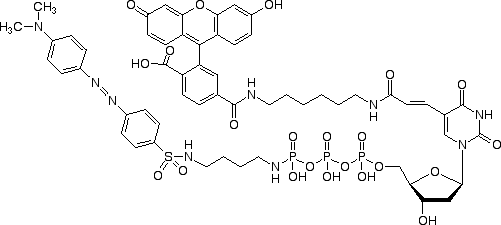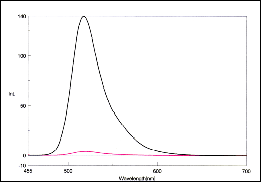Joseph F. Lawler, Jr.
Lawler Scientific, LLC
Several methods have been developed for enzymatic fluorescent labeling of nucleic acids. A dNTP analog can be used to incorporate a fluorophore by PCR, nick translation or random priming, either directly into DNA1 or indirectly via a hapten such as biotin.2 Though high incorporation efficiencies have been reported,3 all of these approaches require the separation of unincorporated label prior to downstream applications.
Lawler Scientific, LLC has developed a series of reagents called Internally Quenched Nucleotides or IQNs. These reagents consist of a nucleoside triphosphate with a fluorescent reporter attached to the nucleobase and a quencher moiety attached to the gamma-phosphate. The nucleotides remain non-fluorescent until the quencher is enzymatically separated from the parent nucleotide. Since the IQNs are non-fluorescent until incorporated into a nucleic acid, they should not give rise to the background fluorescence signals commonly observed when DNA labeled by standard means is inadequately purified.
The first generation IQN consists of a fluorescein-dUTP with a dabsyl quencher linked to the gamma phosphate (see Figure 1). The first generation molecules were developed to address the cDNA labeling application described above. Fluorescein and dabsyl were selected because of their superior optical properties and because the photophysics governing their interaction is well described in the literature.4 In addition, this IQN is soluble and stable in aqueous solution.


Molecular modeling of the fluorescein and dabsyl moieties of the IQN predicts that these moieties will be well within effective quenching distances. Consistent with this prediction is the observation that fluorescence emission of this first generation molecule is >98% quenched (see Figure 2). Chemical fragmentation of the triphosphate backbone restores fluorescence emission as does hydrolysis by snake venom phosphodiesterase (SVP). As shown in the accompanying Figure 3, SVP rapidly hydrolyzes the IQN with a concomitant increase in fluorescence intensity at 520nm.
Reverse transcriptases are commonly used in cDNA labeling protocols. An oligonucleotide primer extension assay was performed using Avian Myeloblastosis Virus (AMV) reverse transcriptase (RT). AMV RT correctly incorporated the IQN opposite dA residues in the template strand. In a second set of experiments, this IQN was added to an AMV RT mediated cDNA synthesis reaction. The addition of the IQN resulted in label incorporation in the resulting 351nt cDNA. cDNA synthesis reactions can therefore be “doped” with IQNs to achieve the desired amount of label incorporation.
The IQN technology may extend microarray and real-time PCR techniques but it would do so in different ways. Microarray hybridization experiments may be made more time- and cost-efficient by eliminating the fluid handling steps associated with the cDNA labeling and purification processes. Real-time PCR based experiments may also be made more time- and cost-efficient by eliminating the empiric and costly process of designing and testing fluorescent quantification probes.


Real time PCRLawler Scientific, LLC also recognized the potential utility of these reagents for monitoring nucleic acid amplification reactions in real time. Several probe based methods have been developed for quantifying PCR. While effective, these methods require the design and synthesis of an oligonucleotide for each amplicon of interest. Since the use of IQNs is independent of the amplicon chosen, IQNs can serve as an “off the shelf” reagent for monitoring the progress of a PCR.Thermophilic DNA polymerases tend to be more stringent than reverse transcriptases with respect to substrate specificity. Using an extensive body of structure activity relationship data, Lawler Scientific, LLC developed a less extensively decorated IQN for use in real-time PCR. A second generation IQN was prepared using pyrrolo-dC, an intrinsically fluorescent nucleobase developed at Glen Research,5 as a fluorophore and dabcyl as a quencher (see Figure 1).Again, the fluorescence emission of pyrrolo-dCTP-dabcyl is >98% quenched (Figure 4) and hydrolysis by SVP leads to the return of fluorescence (Figure 5). The absorbance and emission spectra of pyrrolo-dC allow it to be detected in the presence of other nucleobases and nucleic acids. In addition, pyrrolo-dC is known5 to be incorporated opposite dG positions by Taq DNA polymerase.


Lawler Scientific, LLC is commercializing several additional IQNs with varying fluorophore and quencher pairs. It is anticipated that these molecules will be useful in multiple-color hybridization reactions, SNP analysis, and polymerase detection.These products are subject to proprietary rights of Lawler Scientific, LLC and are made and sold under license from Lawler Scientific, LLC. There is no implied license for commercial use with respect to the Products and a license must be obtained directly from Lawler Scientific, LLC with respect to any proposed commercial use of the Products. For information on licensing to permit commercial applications, please contact Lawler Scientific, LLC at [email protected].
UPDATE -- Guidance on the use of Internally Quenched Nucleotide
Ordering Information Pyrrolo-dCTP-dabcyl and Pyrrolo-dUTP-dabcyl have been discoontinued.